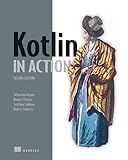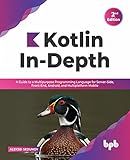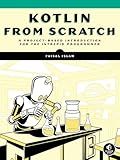Best Kotlin Programming Guides to Buy in December 2025

Kotlin in Action, Second Edition



Kotlin In-Depth: A Guide to a Multipurpose Programming Language for Server-Side, Front-End, Android, and Multiplatform Mobile (English Edition)



How to Build Android Applications with Kotlin: A hands-on guide to developing, testing, and publishing production-grade Android 16 apps



Head First Kotlin: A Brain-Friendly Guide



Kotlin from Scratch: A Project-Based Introduction for the Intrepid Programmer



Functional Programming in Kotlin


In Kotlin, you can filter and sort a dictionary (map) using the filter and toSortedMap functions.
To filter a dictionary, you can use the filter function along with a lambda expression that defines the filtering criteria. This lambda expression takes a key-value pair as input and returns a boolean value indicating whether the pair should be included in the filtered dictionary.
For example, to filter a map based on the values, you can use the following code:
val map = mapOf("a" to 1, "b" to 2, "c" to 3) val filteredMap = map.filter { it.value > 1 } println(filteredMap)
To sort a dictionary, you can use the toSortedMap function along with a Comparator that defines the sorting criteria. This function returns a new sorted dictionary based on the provided Comparator.
For example, to sort a map based on the keys, you can use the following code:
val map = mapOf("b" to 2, "a" to 1, "c" to 3) val sortedMap = map.toSortedMap(compareBy { it }) println(sortedMap)
What is the benefit of using filterValues() function for dictionaries in Kotlin?
The benefit of using the filterValues() function for dictionaries in Kotlin is that it allows you to easily filter the entries of a dictionary based on the values. This can be useful for situations where you want to extract a subset of entries from a dictionary that meet certain criteria, without having to manually iterate over each entry and check the value. The filterValues() function simplifies the process of filtering dictionaries and makes the code more readable and concise.
How to filter a dictionary by key range in Kotlin?
You can filter a dictionary by key range in Kotlin by using the filterKeys function along with a lambda expression. Here's an example of how to filter a dictionary by a specific key range:
fun main() { val dictionary = mapOf( 1 to "Apple", 2 to "Banana", 3 to "Cherry", 4 to "Date", 5 to "Elderberry" )
val filteredDictionary = dictionary.filterKeys { it in 2..4 }
println(filteredDictionary)
}
In this example, the filterKeys function is used to filter the dictionary so that only keys within the range of 2 to 4 are included in the filtered dictionary. The lambda expression { it in 2..4 } checks if the key is within the desired range. The resulting filteredDictionary will contain only the key-value pairs for keys 2, 3, and 4.
You can adjust the key range or the condition within the lambda expression to filter the dictionary based on different key ranges or criteria.
What is the difference between sort and sorted in Kotlin for dictionaries?
In Kotlin, sort is a function that mutates the original collection by sorting it in-place, while sorted is a function that returns a new sorted collection without modifying the original one.
For dictionaries in Kotlin, the sort function is not available as dictionaries do not have a defined order. However, you can use the toList() function to convert the dictionary into a list of key-value pairs and then use the sortedBy function to sort the list based on keys or values. This will return a new list of sorted key-value pairs without modifying the original dictionary.
Example:
val dictionary = mapOf("b" to 2, "a" to 1, "c" to 3)
// Using sortedBy to sort by key val sortedByKey = dictionary.toList().sortedBy { it.first }.toMap() println(sortedByKey) // Output: {a=1, b=2, c=3}
// Using sortedBy to sort by value val sortedByValue = dictionary.toList().sortedBy { it.second }.toMap() println(sortedByValue) // Output: {a=1, b=2, c=3}
What is the significance of filtering a dictionary by excluding specific values in Kotlin?
Filtering a dictionary by excluding specific values in Kotlin can be significant for various reasons.
- Improved performance: By excluding specific values from a dictionary, you can reduce the size of the data structure and improve the performance of operations that need to iterate over the dictionary. This can be particularly useful when dealing with large dictionaries.
- Cleaner code: Filtering a dictionary to exclude specific values can make your code more readable and maintainable. It allows you to focus on the elements that are relevant to your current task and avoid cluttering your code with unnecessary data.
- Selective data retrieval: By excluding specific values from a dictionary, you can easily retrieve only the data that meets certain criteria. This can help you focus on the information that is most important for your particular use case.
- Improved data consistency: Filtering a dictionary to exclude specific values can help ensure that your data remains consistent and up-to-date. By removing irrelevant or outdated values, you can avoid errors and inconsistencies in your application.
Overall, filtering a dictionary by excluding specific values in Kotlin can help you manage your data effectively, improve performance, and make your code more readable and maintainable.
What is the meaning of filtering a dictionary by key-value pair in Kotlin?
Filtering a dictionary by key-value pair in Kotlin refers to the process of selecting and retaining only those entries in the dictionary that satisfy certain conditions based on their keys and values. This allows you to create a new dictionary containing only the key-value pairs that meet the specified criteria. This can be useful for extracting specific data from a dictionary or reducing the size of the dictionary based on certain conditions.
What is the use of filtering a dictionary by value in Kotlin?
Filtering a dictionary (or map) by value in Kotlin is useful for extracting specific entries from the map based on the values associated with those entries. This can be helpful in scenarios where you want to extract and work with only certain elements of the map that meet specific criteria.
For example, you may want to filter a dictionary of student names and their corresponding grades to only include students with a grade higher than a certain threshold. By filtering the dictionary by value, you can easily extract and work with only the entries that meet this criteria without having to iterate over the entire map and manually check each entry.
Overall, filtering a dictionary by value in Kotlin can help you manipulate and work with the data in the dictionary in a more targeted and efficient way based on the values associated with the entries.
